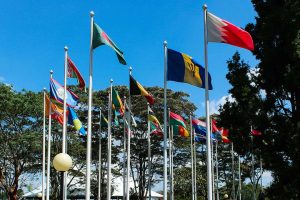14 January 2019: The UN Alliance for Sustainable Fashion announced that it will hold its official launch during the fourth session of the UN Environment Assembly (UNEA-4). The Alliance is composed of UN and specialized agencies, including the World Bank Group’s Connect4Climate, the International Trade Centre’s (ITC) Ethical Fashion Initiative, the International Labour Organization (ILO), the UNFCCC Secretariat, the UN Economic Commission for Europe (UNECE), the UN Environment Programme (UNEP) and the UN Global Compact.
The Alliance represents a culmination of efforts by the UN and others to bring fashion into sustainability initiatives. With UNEP and the ITC serving as the Alliance’s co-secretariat, the Alliance aims to:
- Encourage the private sector, governments and non-governmental organizations (NGOs) to take action to reduce the fashion industry’s negative social, economic and environmental impacts, and turn it into a driver for SDG implementation;
- Allow for standards across the industry and among agencies; and
- Increase awareness to change unsustainable consumption and production patterns in fashion.
The fashion industry is the second-highest user of water worldwide, emits 10% of global carbon emissions, and employs one in six people globally.
Alliance Co-Secretary Michael Stanley-Jones said the Alliance will coordinate the UN system’s response to challenges faced by the textiles, fashion and accessories sectors in achieving the 2030 Agenda for Sustainable Development and SDGs. He said that, due to its cross-cutting nature, fashion demands a comprehensive, integrated approach, and joint action by producers, consumers and governments. He called fashion “sustainable development’s greatest challenge and its greatest opportunity.”
The USD 2.5 trillion industry is the second highest user of water worldwide, generating 20% of global water waste, with a pair of jeans requiring about 2,000 liters of water to produce. Around one in six people, or 75 million people, globally work in fashion-related jobs, with women comprising 80% of the labor force throughout the supply chain, according to UNECE. In addition, the industry emits around 10% of global carbon emissions, and every second, the equivalent of one garbage truck of textiles is landfilled or burned. Continuing with business as usual, the fashion industry will use up a quarter of the world’s carbon budget by 2050. The industry also contributes to plastic entering the ocean, and is responsible for dangerous working conditions due to unsafe processes and hazardous substances used in production.
With the number of times a garment is worn declining by 36% in the past 15 years, some proposed solutions to counter this “throwaway culture” include rental markets with a sufficient choice of styles and brands, and keeping and using clothing for longer to reduce its environmental footprint.
UNEA-4 will convene in Nairobi, Kenya, in March 2019. The launch event is expected to highlight recent achievements by Alliance members, such as the Fashion Industry Charter for Climate Action released by the UNFCCC in December 2018, and to increase support for a multi-stakeholder strategy to address the fashion agenda for sustainable development. [UNECE Press Release] [UNEP Press Release]
SDGs
Issues
- Biodiversity,
- Climate Change,
- Economics & Investment,
- Energy,
- Sustainable Use,
- Gender,
- Governance,
- Human Rights & Indigenous Peoples,
- Industrial Development,
- Monitoring & Evaluation,
- Poverty Eradication,
- Sustainable Consumption & Production,
- Sustainable Development,
- Stakeholder Participation,
- Transport,
- Water & Sanitation

